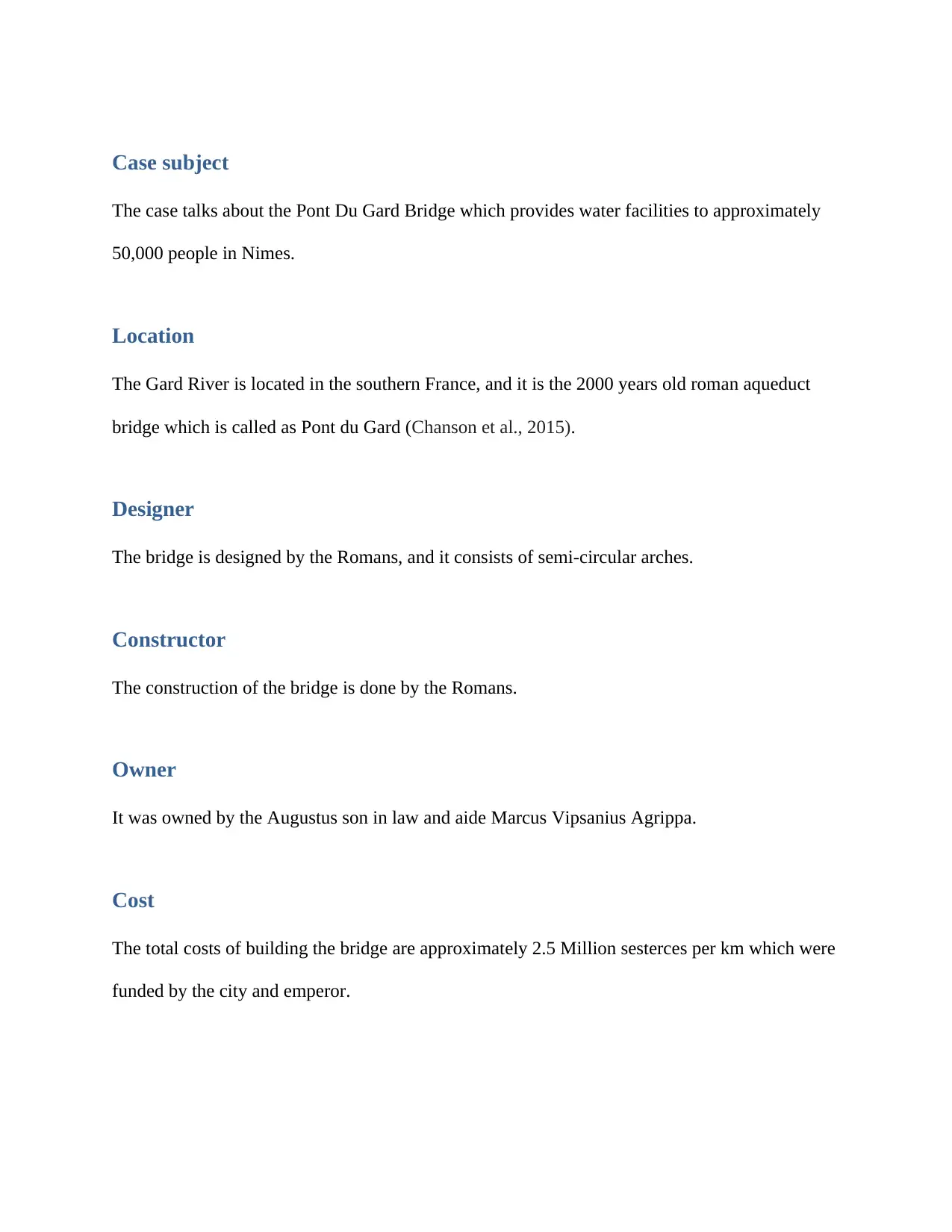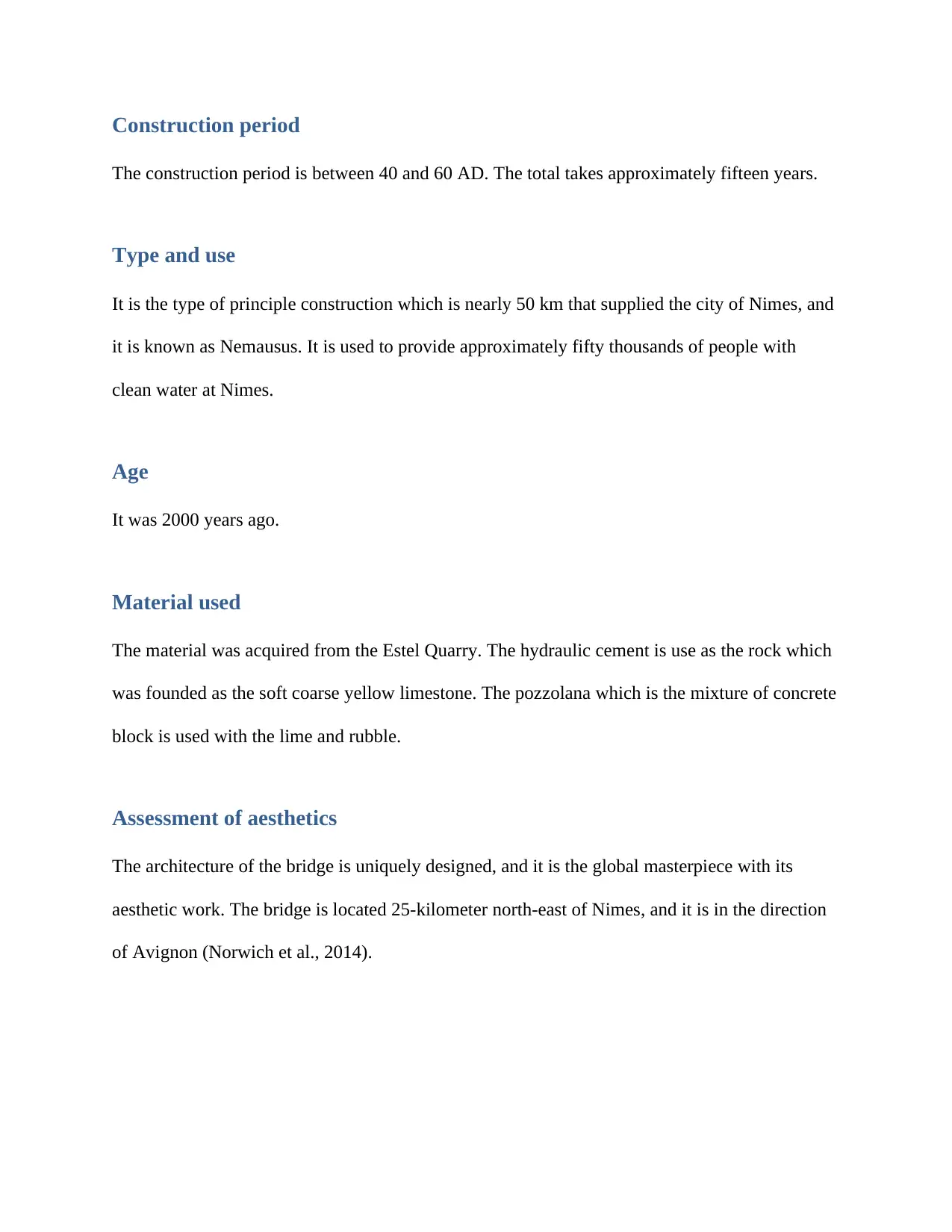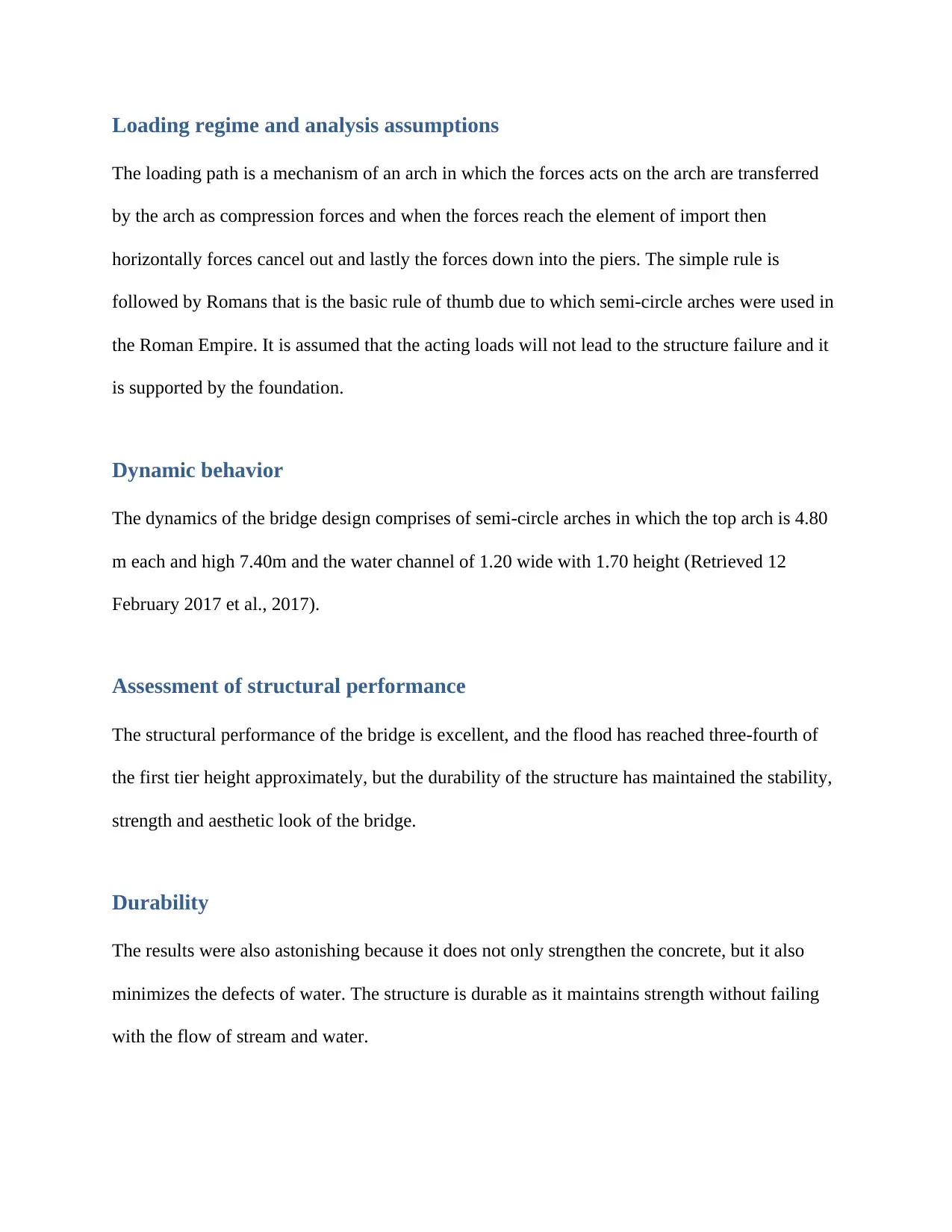Pont Du Gard Bridge Case Study
VerifiedAdded on 2019/09/20
|9
|722
|247
Case Study
AI Summary
This document presents a case study of the Pont Du Gard Bridge, a Roman aqueduct located in southern France. It details the bridge's location, designer, constructor, owner, and cost. The construction period, type, and use of the bridge are also discussed, along with its age and the materials used. The study assesses the bridge's aesthetics, loading regime, dynamic behavior, structural performance, and durability. It also addresses sustainability issues related to the aqueduct. The document includes references to support the information provided.

Civil Engineering Journal
Paraphrase This Document
Need a fresh take? Get an instant paraphrase of this document with our AI Paraphraser

Case subject
The case talks about the Pont Du Gard Bridge which provides water facilities to approximately
50,000 people in Nimes.
Location
The Gard River is located in the southern France, and it is the 2000 years old roman aqueduct
bridge which is called as Pont du Gard (Chanson et al., 2015).
Designer
The bridge is designed by the Romans, and it consists of semi-circular arches.
Constructor
The construction of the bridge is done by the Romans.
Owner
It was owned by the Augustus son in law and aide Marcus Vipsanius Agrippa.
Cost
The total costs of building the bridge are approximately 2.5 Million sesterces per km which were
funded by the city and emperor.
The case talks about the Pont Du Gard Bridge which provides water facilities to approximately
50,000 people in Nimes.
Location
The Gard River is located in the southern France, and it is the 2000 years old roman aqueduct
bridge which is called as Pont du Gard (Chanson et al., 2015).
Designer
The bridge is designed by the Romans, and it consists of semi-circular arches.
Constructor
The construction of the bridge is done by the Romans.
Owner
It was owned by the Augustus son in law and aide Marcus Vipsanius Agrippa.
Cost
The total costs of building the bridge are approximately 2.5 Million sesterces per km which were
funded by the city and emperor.

Construction period
The construction period is between 40 and 60 AD. The total takes approximately fifteen years.
Type and use
It is the type of principle construction which is nearly 50 km that supplied the city of Nimes, and
it is known as Nemausus. It is used to provide approximately fifty thousands of people with
clean water at Nimes.
Age
It was 2000 years ago.
Material used
The material was acquired from the Estel Quarry. The hydraulic cement is use as the rock which
was founded as the soft coarse yellow limestone. The pozzolana which is the mixture of concrete
block is used with the lime and rubble.
Assessment of aesthetics
The architecture of the bridge is uniquely designed, and it is the global masterpiece with its
aesthetic work. The bridge is located 25-kilometer north-east of Nimes, and it is in the direction
of Avignon (Norwich et al., 2014).
The construction period is between 40 and 60 AD. The total takes approximately fifteen years.
Type and use
It is the type of principle construction which is nearly 50 km that supplied the city of Nimes, and
it is known as Nemausus. It is used to provide approximately fifty thousands of people with
clean water at Nimes.
Age
It was 2000 years ago.
Material used
The material was acquired from the Estel Quarry. The hydraulic cement is use as the rock which
was founded as the soft coarse yellow limestone. The pozzolana which is the mixture of concrete
block is used with the lime and rubble.
Assessment of aesthetics
The architecture of the bridge is uniquely designed, and it is the global masterpiece with its
aesthetic work. The bridge is located 25-kilometer north-east of Nimes, and it is in the direction
of Avignon (Norwich et al., 2014).
⊘ This is a preview!⊘
Do you want full access?
Subscribe today to unlock all pages.

Trusted by 1+ million students worldwide

Loading regime and analysis assumptions
The loading path is a mechanism of an arch in which the forces acts on the arch are transferred
by the arch as compression forces and when the forces reach the element of import then
horizontally forces cancel out and lastly the forces down into the piers. The simple rule is
followed by Romans that is the basic rule of thumb due to which semi-circle arches were used in
the Roman Empire. It is assumed that the acting loads will not lead to the structure failure and it
is supported by the foundation.
Dynamic behavior
The dynamics of the bridge design comprises of semi-circle arches in which the top arch is 4.80
m each and high 7.40m and the water channel of 1.20 wide with 1.70 height (Retrieved 12
February 2017 et al., 2017).
Assessment of structural performance
The structural performance of the bridge is excellent, and the flood has reached three-fourth of
the first tier height approximately, but the durability of the structure has maintained the stability,
strength and aesthetic look of the bridge.
Durability
The results were also astonishing because it does not only strengthen the concrete, but it also
minimizes the defects of water. The structure is durable as it maintains strength without failing
with the flow of stream and water.
The loading path is a mechanism of an arch in which the forces acts on the arch are transferred
by the arch as compression forces and when the forces reach the element of import then
horizontally forces cancel out and lastly the forces down into the piers. The simple rule is
followed by Romans that is the basic rule of thumb due to which semi-circle arches were used in
the Roman Empire. It is assumed that the acting loads will not lead to the structure failure and it
is supported by the foundation.
Dynamic behavior
The dynamics of the bridge design comprises of semi-circle arches in which the top arch is 4.80
m each and high 7.40m and the water channel of 1.20 wide with 1.70 height (Retrieved 12
February 2017 et al., 2017).
Assessment of structural performance
The structural performance of the bridge is excellent, and the flood has reached three-fourth of
the first tier height approximately, but the durability of the structure has maintained the stability,
strength and aesthetic look of the bridge.
Durability
The results were also astonishing because it does not only strengthen the concrete, but it also
minimizes the defects of water. The structure is durable as it maintains strength without failing
with the flow of stream and water.
Paraphrase This Document
Need a fresh take? Get an instant paraphrase of this document with our AI Paraphraser

Sustainability issues
The issue is related to the environmental problems and maintaining the aqueduct because the
carbonates precipitated out of the water through the conduit at the time of journey which reduced
the flow of water and it is the sustainability issue which needs to be maintained.
The issue is related to the environmental problems and maintaining the aqueduct because the
carbonates precipitated out of the water through the conduit at the time of journey which reduced
the flow of water and it is the sustainability issue which needs to be maintained.

References
(2017). Retrieved 12 February 2017, from
https://s3.amazonaws.com/prod_object_assets/assets/270307193912470/
Group_3_Pont_du_Gard.pdf?
AWSAccessKeyId=ASIAIJFDZFDIJ7VT62NA&Expires=1486826536&Signature=rWaqFMVT
65bd6%2BYSjJMKvA7zYWw%3D&x-amz-security-token=FQoDYXdzEKf%2F%2F%2F%2F
%2F%2F%2F%2F%2F
%2FwEaDGVZ9N0kwBA8MV6TiyK3A0aj4sDM0DIZsuII4oTo4URP0ZxTYn7K
%2BLimRzx6Ziu0OPY2DWSXKQzCgJdFHbpvBHG8hKzrJ1fz4YvObvJ
%2BIiIv1tBio3pcuOW0QxkSvOryy1mkisOTgdpMQUl
%2FNF8rlaREkKJJfl84dIAVQ2c3UTRC9b1P0k5p0TE
%2F4Vcbv2GtTTy1DLvGv2KHAP1QvByIAZoUNcLIZ4diy9dzuKEiNChu
%2BeA34c8HpRusYgIBfhk6RuIATxnaGRtsnFhShxls8V66z8tKR15YQW
%2B5Em553%2BO8W9H%2FNVX%2Bi58zGpGA
%2FUiqd9M5WHItUWuknFLMpATFuo311aXrgNIwov4Fwq4pOxaLXsOJkw1Eft4W42b4wye
w4A2SQm2quh9CCFHDs%2FTwlvivscOwn4zp7k7p0DOxiHebgkokcSZ05eLdGBW
%2FQLS0GfDD%2FxMuUkC4r9Te0UKdno6Vc%2Fd7KIrpAMu6DSG3Fi204uHAoNE1B
%2F7ZbGzXd2DSSEfe8m9Z1ZUqjHeyPV8WzCNOBRhJt
%2Brsxvqr8i2rVlLkZ9lGQ0nwreSqxGUuNc5%2BXWTnIn%2B61yX7tXbM%2F31Gtz
%2Bq761bT6wo87n8xAU%3D#_=_
Chanson, H. (2015). Hydraulic engineering and roman aqueducts: modern perspectives. In IV
Jornadas de Ingeniería del Agua (pp. 21-30). University of Córdoba.
(2017). Retrieved 12 February 2017, from
https://s3.amazonaws.com/prod_object_assets/assets/270307193912470/
Group_3_Pont_du_Gard.pdf?
AWSAccessKeyId=ASIAIJFDZFDIJ7VT62NA&Expires=1486826536&Signature=rWaqFMVT
65bd6%2BYSjJMKvA7zYWw%3D&x-amz-security-token=FQoDYXdzEKf%2F%2F%2F%2F
%2F%2F%2F%2F%2F
%2FwEaDGVZ9N0kwBA8MV6TiyK3A0aj4sDM0DIZsuII4oTo4URP0ZxTYn7K
%2BLimRzx6Ziu0OPY2DWSXKQzCgJdFHbpvBHG8hKzrJ1fz4YvObvJ
%2BIiIv1tBio3pcuOW0QxkSvOryy1mkisOTgdpMQUl
%2FNF8rlaREkKJJfl84dIAVQ2c3UTRC9b1P0k5p0TE
%2F4Vcbv2GtTTy1DLvGv2KHAP1QvByIAZoUNcLIZ4diy9dzuKEiNChu
%2BeA34c8HpRusYgIBfhk6RuIATxnaGRtsnFhShxls8V66z8tKR15YQW
%2B5Em553%2BO8W9H%2FNVX%2Bi58zGpGA
%2FUiqd9M5WHItUWuknFLMpATFuo311aXrgNIwov4Fwq4pOxaLXsOJkw1Eft4W42b4wye
w4A2SQm2quh9CCFHDs%2FTwlvivscOwn4zp7k7p0DOxiHebgkokcSZ05eLdGBW
%2FQLS0GfDD%2FxMuUkC4r9Te0UKdno6Vc%2Fd7KIrpAMu6DSG3Fi204uHAoNE1B
%2F7ZbGzXd2DSSEfe8m9Z1ZUqjHeyPV8WzCNOBRhJt
%2Brsxvqr8i2rVlLkZ9lGQ0nwreSqxGUuNc5%2BXWTnIn%2B61yX7tXbM%2F31Gtz
%2Bq761bT6wo87n8xAU%3D#_=_
Chanson, H. (2015). Hydraulic engineering and roman aqueducts: modern perspectives. In IV
Jornadas de Ingeniería del Agua (pp. 21-30). University of Córdoba.
⊘ This is a preview!⊘
Do you want full access?
Subscribe today to unlock all pages.

Trusted by 1+ million students worldwide

Norwich, J. J. (Ed.). (2014). Cities that Shaped the Ancient World. Thames & Hudson.
Paraphrase This Document
Need a fresh take? Get an instant paraphrase of this document with our AI Paraphraser


⊘ This is a preview!⊘
Do you want full access?
Subscribe today to unlock all pages.

Trusted by 1+ million students worldwide
1 out of 9
Your All-in-One AI-Powered Toolkit for Academic Success.
+13062052269
info@desklib.com
Available 24*7 on WhatsApp / Email
![[object Object]](/_next/static/media/star-bottom.7253800d.svg)
Unlock your academic potential
Copyright © 2020–2025 A2Z Services. All Rights Reserved. Developed and managed by ZUCOL.

